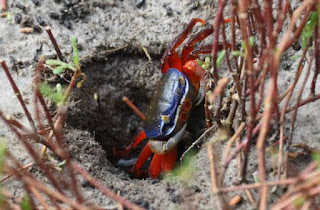What is mean by the term Ramsar site?
It is basically a international treaty signed in 1971 for global conservation and sustainable use of wetlands. Ramsar is a city situated in Iran in which the first Convention is held and inter -government accords for preserving the ecological character of wetlands
First we have to understand the term wetlands!!
A wetlands are patch of land where land is covered by water or is present either at or near the surface of the soil throughout the year. It can be intersection point between terrestrial and aquatic ecosystem in which moisture remains all the times. It can contain water in the types as freshwater, salt water or brakish water.
It is usually found in low lying areas or also can be both natural and man made.
These wetlands may exist as coastal and inlands,
Floodplains,swamps and marshes, mangroves and delta.
You may also consider agricultural paddy land as also a wetlands.
Wetands is the most productive ecosystem in the world as compared to rainforest and coral reefs which is home to diverse aquatic plants, intersects, amphibians,reptiles,birds,mammals and many microbial bacterial communities .
Importance of wetlands!!
As mentioned above that it provides habitat to diverse species
Wetlands also provide livelihood sources to humans in terms of agriculture produce, craft materials, timber production, medicinal plants, fishing hunting etc.
It helps to recycle nutrients that so important for many other surrounding ecosystems
Wetlands are act as sponge which absorb pollutants and improve the water quality by filtering out sedimentation, decomposing vegetative matter and converting chemical into a useful form
It also helps in recharging ground water
Wetlands like mangroves also protect shores from any kind of floods, atleast it reduces the impact of it by reducing the momentum of the incoming raining water
Most important it promotes tourism which further increases the capital inflow from different countries of the world
Some facts related to wetlands are as follows
Right now there are around 170 member nations listed in Ramsar
This convention came into force in india on 1 feb ,1982
There are around 2400 Ramsar sites world wide and 41 Ramsar sites are found in india which makes it highest in south Asia
It covers around 2.5 million square kilometers world wide
Bolivia has the highest area with 1,48,000 square kilometers under Ramsar protection
Europe has the maximum number of wetlands sites in which the countries with most sites are the united Kingdom with 175 and Mexico with 142
The world's first site was the cobourg peninsula in Australia designated in 1974
2 Feb is celebrated as international wetlands day and all the work is under UNESCO a part of UNO
Its aim to develop and sustain a network of wetlands by maintaining components of their ecosystem and processes
All wetlands are protected under strict guidelines of the convention. Like flood moderation, erosion and climate change
There is a records called montreux record which act as register of wetlands sites on the list of international importance where changes in ecological character occurred, are occurring ,or are likely to occur as a result of technological developments, pollution and other consequences as ecological change due to climate change, human interference and also improvement due to technological advancements. By and large it acts as checks on pollution, human interference and any kind of exploitation
Once a nation enlisted in Ramsar sites then it will able to gain access to the knowledge of how to conserve and make sustainable use of wetlands and experts and officials from Ramsar advisory mission may visit the member country ,analyze the situation and define how to tackle the threats
Wetlands description in indian geographical context
There are currently 41 Ramsar sites listed wetlands are as follows
Vembanad kol wetland (Kerala)
Sasthamkotta lake (Kerala)
Beas conservation Reserve (Punjab)
Harike wetlands (Punjab)
Kanjili wetlands (Punjab)
Keshopur-miani community Reserve (Punjab)
Nangal wildlife sanctuary (Punjab)
Ropar wetland (Punjab)
Bhitarkanika mangroves (odisha)
Chilika lake (odisha)
Bhoj wetlands (madhya pradesh)
Chandra taal (himachal pradesh)
Pong dam lake (himachal Pradesh)
Renuka lake (himachal pradesh)
Deepor beel (Assam)
East kolkata wetlands (west Bengal)
Sunderban wetland (west Bengal)
Hokera wetland (Jammu and kashmir)
Surinsar -Mansar lakes (Jammu and kashmir)
Wular lake (Jammu and kashmir)
Keoladeo national park (Rajasthan)
Sambhar lake (Rajasthan)
Kolleru lake (Andhra pradesh)
Loktak lake (Manipur)
Rudrasagar lake (Tripura)
Saman Bird sanctuary (uttar pradesh)
Samaspur bird sanctuary (uttar pradesh)
Sandi bird sanctuary (uttar pradesh)
Sarsai nawar jheel (utter Pradesh)
Upper ganga river (uttar Pradesh)
Sur sarovar (uttar pradesh)
Parvati Agra bird sanctuary (uttar Pradesh)
Nandur madhameshwar (Maharashtra)
Lonar lake (Maharashtra)
Nalsarovar bird sanctuary (Gujarat)
Point calimere wildlife and bird sanctuary (Tamil nadu)
Tsomoriri (Ladakh)
Asan barrage (uttrakhand)
Kanwar lake or kabal taal ( Bihar)
However they continue to be among the most threatened ecosystems due to going drainage and over exploitation of their resources. There is need for strict implemention of polices of concerned government in consonance with international fora.










